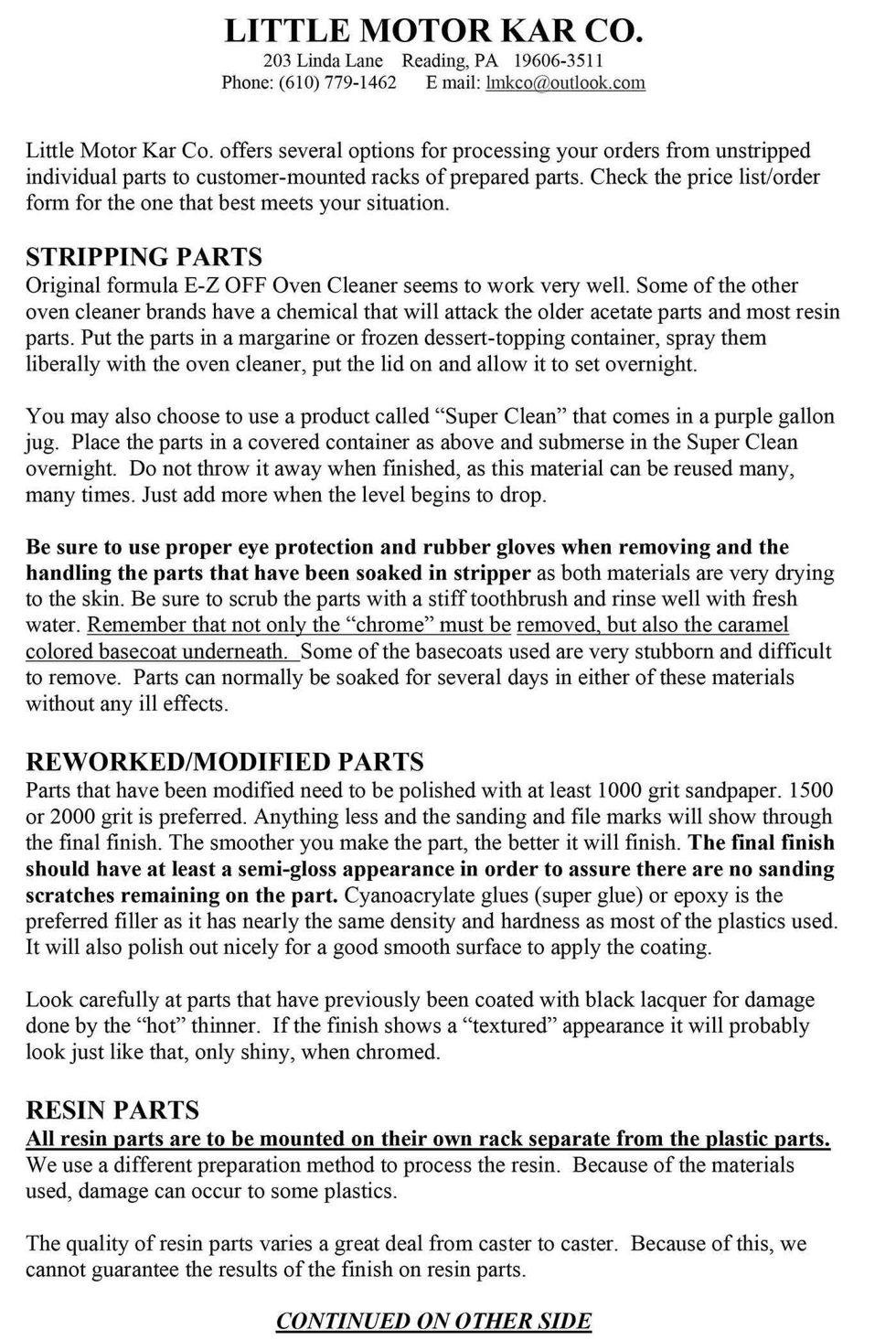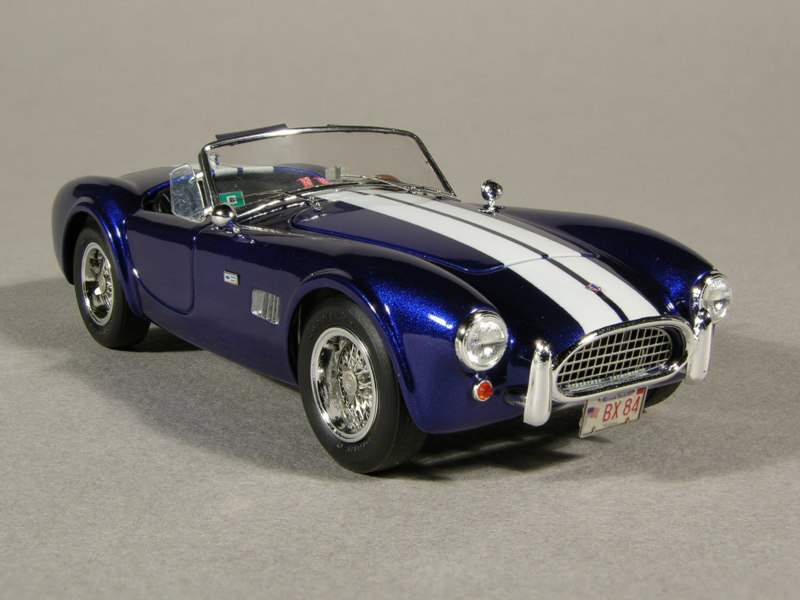-
Posts
9,217 -
Joined
-
Last visited
Content Type
Profiles
Forums
Events
Gallery
Everything posted by peteski
-

Stripping the clear coat under chrome?
peteski replied to Street Rod's topic in Model Building Questions and Answers
Yes, Lye is another name for Soduim-hydroxide. I have successfully used the Castrol Super Clean, Easy-Off original formula oven cleaner, my own mix of lye granules and water, and few other lye-based paint removers (which are no longer made), and they all stripped the aluminum layer and clear coating from model parts. So my experience is different than yours. Important thing for me is to keep the stripping solution warm. Also would not recommend anything called "lacquer thinner" to strip paint or "chrome" from polystyrene model parts. I seem to recall similar discussion about this on another thread. Again, out experiences differ. -

Stripping the clear coat under chrome?
peteski replied to Street Rod's topic in Model Building Questions and Answers
You didn't mention what you used to strip the metallic layer, but if you used any of the many lye-based paint stripping solution, that would have removed both,the metallic layer and the clear coat. We recently discussed this subject on the forum. To clarify, I'm talking about Easy-Off oven cleaner (original formula), "Purple Stuff". LA Totally Awesome concentrated cleaner, and similar. -

Another Can Of Testor's Bites The Dust
peteski replied to oldcarfan's topic in Model Building Questions and Answers
If some of the paint/binder leaked out of the can at the bottom seal there is a good chance that the propellant also escaped, so there is no pressure inside to spray the paint out. That can be easily verified by trying to squeeze the can with your hand. If the can gives in easily, the pressure is gone. -
Proxxon tools are decent hobby grade tools. I have some of them (not the lathe) and they are usable. From what I see, the hollow extruded aluminum bed and rails will not be as rigid as the steel one on Sherline, but should be sufficient for most hobby needs (machining relatively soft materials).
-
Another thing about Sherlines is that they are what I consider "hobbyist's workbench size". They are small and light enough to be easily moved around if needed. I actually have my lathe and mill bolted to wooden bases with rubber feet, so they are quite portable (as my workbench space is at premium). That way I can have either lathe or mill on the workbench when the other one sits on a shelf. Unimat would be in the same category. Other lathes or mills, even small ones can be quite bulky and heavy. Yes, they are also more powerful than Sherline, but for my needs (small usually plastic, aluminum or brass parts), I don't need much power.
-
Yes, over the last few days the forum seemed to be slower than usual. But no errors for me - just several seconds to bring up a thread or to post a message.
-
Another happy Sherline user here (for over 30 years). What is great about Sheline (besides that it's made in USA), is its modular construction. I started with a plain lathe, then later added a vertical milling column to easily convert it into small milling machine and back to lathe. Several years later, I sent that vert. milling column to be installed on the XY table they use for their standard milling machine. I also bought a second spindle assy. with the motor to end up with a complete milling machine which cost me less than buying a complete mill from Sherline. Oh, my original lathe came with an AC motor, and when they came out with a new more powerful and smoother DC motor, I was able to upgrade the AC motor to DC. The modular construction can't be beat. You can upgrade as the time goes by. They also have huge array of accessories and adapters.
-

Any Drawbacks To Using Bondic As A Clear Lense?
peteski replied to oldcarfan's topic in Model Building Questions and Answers
Unlike its name implies, it is not a glue, so it doesn't bond really well to anything. It should not stick to any sort of rubbery mold. Also the resin doesn't fully harden and stays sticky on the surface. It is soft (sort of like a really firm Gummi Bear. At least in my experience. I was able to set it harder by leaving it in full Summer sunlight for 15 minutes. If you want to experiment with UV-cured resins, Bondic is rather pricey. Craft stores sell larger containers of the resin, or look for it on eBay or amazon. It is more economical that way. Alos get a stronger UV light source or use Sunlight to harden the resin. -

How to use Metallic paints
peteski replied to George Rom's topic in Model Building Questions and Answers
This is an older thread (from Nov. 15, 2023) and the person asking the question (which was also their first post) has not even visited here since January 8. We probably won't get any more details. -

Best way to chrome plate resin wheels?
peteski replied to mikemodeler's topic in Model Building Questions and Answers
I emailed Dale in the past but after waiting for a long time with no reply I called him. He told me that he doesn't check emails very often. Better try calling. Here is the info (sorry I only have this single page with contact info). -

Another Can Of Testor's Bites The Dust
peteski replied to oldcarfan's topic in Model Building Questions and Answers
Duplicate post - deleted. -

Another Can Of Testor's Bites The Dust
peteski replied to oldcarfan's topic in Model Building Questions and Answers
The assumption here is that Gary has and uses an airbrush. -
You don't understand. I have spend close to a year on some of my builds. It is about time management. To me it is a waste of time to sand. rub, polish, or wax a paint job. It would be waste of time trying to rescue a glue bomb. I just dislike those tasks, and find them unnecessary. I rather use that time I save on not doing those things for building another model. My paint jobs will not be like yours, and I'm ok with that. But on the other hand, would you be able to design and build an electronic circuits to illuminate your model? Not just a a simple LED/resistor light, but a complex electronic circuit? Our modeling goals are quite different, but yet we both enjoy our hobby. After all, we build models for our own pleasure and satisfaction. I doubt that you'll ever understand me, but I'm ok with that. For a selection of my models you can visit http://classicplastic.org/pete-w.html . I remember that you do not generally click on links to any external contents, but if you do want to see some examples of my models, click on the link.
-

One-Off Quiz #43 - Finished
peteski replied to carsntrucks4you's topic in Real or Model? / Auto ID Quiz
So it was rear-engined. Makes sense with the driver's feet and pedals way up in the car's nose. -

News from Nuremberg:Tamiya Giuilia Sprint GTA is back!
peteski replied to Matt Bacon's topic in Car Kit News & Reviews
Awesome news! -
You hit the nail on the head: The time consuming part is what I avoid. To me that is a waste of time, in the same category as restoring glue-bombs. I'm also quite happy with my unpolished and unwaxed paint jobs. I rather spend my time on other aspects of model building. Since the my first model kit I built as a kid, to where I am now, I have never polished or waxed a model. Well, I take it back. One time I had a piece of debris stuck in paint of a trunk lid, and I sanded and polished it. No waxing. I'm not saying Call it a short cut, or maybe not, but a quick lesson on how to cut and polish is light years easier and far less intimidating than telling a novice just to “paint it good”. All I'm saying is that it is possible to get from mediocre to quite good without the need to rub, polish and wax. That is based on my experience. One just hast to gain the experience over time. And it will not always be perfect either, even when one learns to lay down good paint jobs. Like you mentioned, to each his own.
-
The original formula uses Lye (sodium hydroxide) as its active ingredient. Lye is what dissolves the thin aluminum "chrome" layer, and also softens the clear lacquer base coat. The no-fumes formula I believe uses another chemical.
-
Yes, that's what I was going to suggest. Works really well for larger scale models, but even with the weave and overall thickness being a bit out of scale for 1:24/25 models, I think it will look good.
-

One-Off Quiz #43 - Finished
peteski replied to carsntrucks4you's topic in Real or Model? / Auto ID Quiz
Is that a pedal car for adults, or does it have an engine in it? Or maybe just bunch of hamsters running it? If there is an engine, it must be in the rear because the driver's legs are probably taking up most of the under hood space. -
Sure, it is underground in your development, but that is just last several hundred feet. Outside of your development the utilities come back up to regular utility poles and subjected to a typical damage by the weather or careless drivers.





